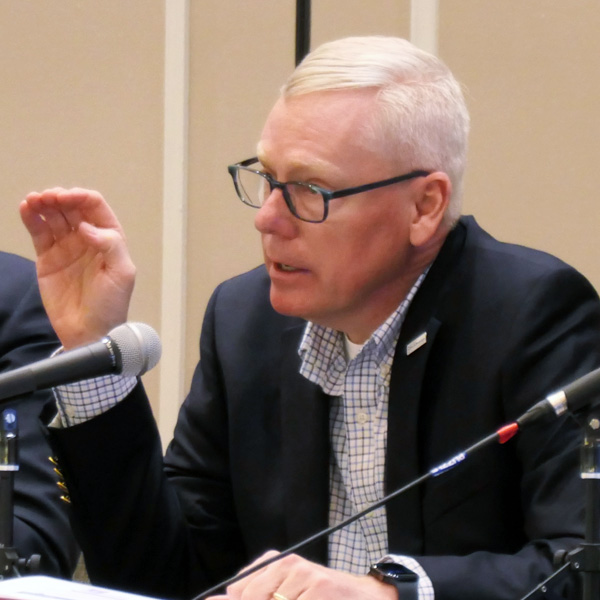[EDITOR’S NOTE: This story previously incorrectly stated that the MRC would attend next May’s joint meeting in D.C. with the Board of Trustees virtually. While other stakeholders will attend the meeting virtually, the MRC will meet in-person along with the board.]
NEW ORLEANS — Stakeholders from across the ERO Enterprise gathered in New Orleans this week for the meeting of NERC’s Member Representatives Committee and Board of Trustees.
At Wednesday’s board meeting, NERC CEO Jim Robb joked that it was “great to be here in person and not watching from … the 23rd floor,” referring to his absence from the last MRC and board meetings in Vancouver. Robb tested positive for COVID-19 while on site and, in accordance with NERC’s policy — which was also in place this week — remained in his room while listening to the events via webcast. (See “Vancouver Hosts Return to In-person Meetings,” NERC Board of Trustees/MRC Briefs: Aug. 17-18, 2022.)
Board Makes Meeting Changes Official
In his remarks to the MRC meeting on Tuesday, NERC board Chair Ken DeFontes confirmed that the organization has decided to implement the new meeting schedule previewed at last week’s meeting of its Corporate Governance and Human Resources Committee. (See NERC Still Considering Scaling Back Board Meetings.)
Under the planned schedule, the MRC and board will hold two fully in-person meetings next year: one in February in Tucson, Ariz., and another in August in Ottawa, Canada. David Morton, chair of the Canadian Association of Members of Public Utility Tribunals, described the meeting in Ottawa as an important opportunity for the board to communicate with Canadian regulators, while the February meeting will include a stakeholder dinner, which DeFontes called “a chance for us to [thank] and recognize some key contributors.”
For the May meeting, which is being held at NERC’s new headquarters in D.C., the ERO plans to conduct a hybrid format in which only the board and MRC will meet one-on-one, while other stakeholders attend virtually. The last gathering of the year will be held entirely online; only the board is expected to meet for now, although DeFontes said a virtual MRC meeting could be arranged “should there come a need for some [actions] by the MRC.”
The new schedule is intended to reduce the costs of attending meetings for the ERO by easing the planning burden for NERC staff and eliminating two meetings’ worth of travel costs for most stakeholders. NERC staff told ERO Insider that the organization hopes the communication technology upgrades at its newly renovated D.C. office will improve the experience for those attending the May meeting virtually.
MRC Leadership Election
The MRC unanimously chose Jennifer Flandermeyer of Evergy and John Haarlow of the Snohomish County Public Utility District to serve as chair and vice chair, respectively, for 2023. Flandermeyer, who is currently vice chair, will take over the top spot from ElectriCities CEO Roy Jones.
BC Hydro’s Paul Choudhury, who chaired the MRC in 2021, briefly took over management of the meeting when Flandermeyer and Haarlow left the room during the vote. Because the MRC’s meetings were held virtually during Choudhury’s tenure, Flandermeyer joked that the opportunity to run the gathering in-person was “a gift” for the former chair.
Nominations are open through Thursday for sector representatives to replace those whose terms will expire in February 2023. The election will be held Dec. 14 to 23.
Standards Actions
The board voted unanimously to adopt the new reliability standard CIP-003-9 (Cybersecurity — security management controls), which will now be sent to FERC for approval.
CIP-003-9 is the product of Project 2020-03, set up by NERC in 2020 to address the risk of low-impact cyber assets with remote electronic access connectivity on the bulk electric system, as recommended in the ERO’s Supply Chain Risk Assessment report in 2019. NERC’s Vice President of Engineering and Standards Howard Gugel explained that the new standard, an update to CIP-003-8, adds a requirement for utilities to include “vendor electronic remote access security controls” in their cybersecurity policies, along with guidelines for how those controls are to be implemented.
Gugel also brought to the board for approval a new white paper drafted by the organization’s Low Impact Criteria Review Team. Gugel reminded the board that they authorized the team to examine “the issue of coordinated attacks on low[-impact cyber assets] and whether or not additional controls should be placed around [them] to help protect against coordinated attacks.”
The paper was posted for industry comment earlier this year and garnered “very supportive comments,” Gugel said. Its recommendations include further revisions to NERC’s Critical Infrastructure Protection (CIP) standards to improve user authentication procedures and security, new security guidelines around protection of communications with and between low-impact assets, and continuous monitoring of risk reports from the Electricity Information Sharing and Analysis Center. The board voted unanimously to accept the white paper.
In addition, the board accepted NERC’s Reliability Standards Development Plan (RSDP) for 2023-2025. The RSDP is “a snapshot of all of the projects that we have in place at this point,” Gugel said, which the organization has to file with regulatory agencies each year.
Along with the approvals at this meeting, Robb noted in his opening remarks the recent passage of NERC’s new cold weather standards EOP-012-1 (Extreme cold weather preparedness and operations) and EOP-011-3 (Emergency operations), which the board approved in a virtual meeting last month. (See NERC Board Approves New Cold Weather Standards.) The CEO thanked NERC’s standards developers for their work, which he called a “very important first step” in addressing the ongoing challenges posed by climate change.
GADS Expansion Gets Board OK
John Moura, director of reliability assessment and performance analysis at NERC, brought to the board a request to approve an update to the Generating Availability Data System (GADS), which trustees approved. The update will expand GADS, which currently covers conventional generation resources and some wind facilities, to include solar facilities and grid-connected energy storage, along with patching some gaps in its wind coverage.
In his presentation, Moura explained that while the behavior of traditional generation resources under a wide range of circumstances is well understood, the rapid expansion of renewable generation resources on the grid has outpaced grid planners’ understanding of their performance characteristics. The expansion of GADS is meant to give NERC’s assessment staff more insights into these assets and how they might react under pressure.
“To forecast energy assurance in the future, understanding the performance of the generation fleet that we have is fundamental; it is a must when we’re considering the reliability assessment obligations of the ERO,” Moura said.





